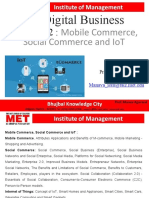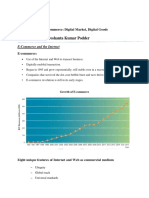0% found this document useful (0 votes)
37 views7 pagesPaper Presentation 1
This document explores the relationship between mobile commerce (m-commerce) and social networks, highlighting how social media platforms enhance consumer behavior and marketing strategies in retail. It discusses the benefits and challenges of this integration, including the need for seamless user experiences and privacy concerns. The study also outlines future trends in m-commerce, such as augmented reality, voice commerce, and the rise of social commerce, indicating a transformative shift in shopping experiences.
Uploaded by
Shruthika SasiramCopyright
© © All Rights Reserved
We take content rights seriously. If you suspect this is your content, claim it here.
Available Formats
Download as DOCX, PDF, TXT or read online on Scribd
0% found this document useful (0 votes)
37 views7 pagesPaper Presentation 1
This document explores the relationship between mobile commerce (m-commerce) and social networks, highlighting how social media platforms enhance consumer behavior and marketing strategies in retail. It discusses the benefits and challenges of this integration, including the need for seamless user experiences and privacy concerns. The study also outlines future trends in m-commerce, such as augmented reality, voice commerce, and the rise of social commerce, indicating a transformative shift in shopping experiences.
Uploaded by
Shruthika SasiramCopyright
© © All Rights Reserved
We take content rights seriously. If you suspect this is your content, claim it here.
Available Formats
Download as DOCX, PDF, TXT or read online on Scribd
/ 7























































































